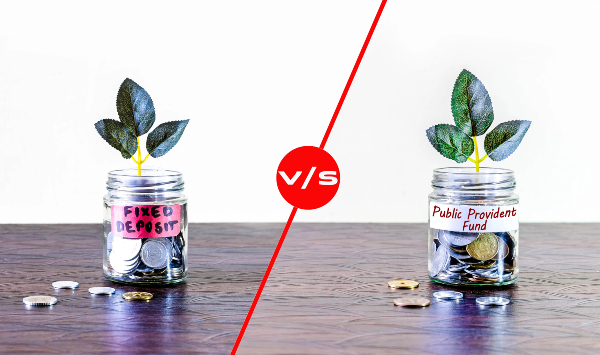Public Provident Fund (PPF) vs Fixed Deposit (FD): Depending on a person’s unique financial status and investment objectives, both a fixed deposit (FD) and a public provident fund (PPF) can be excellent options for saving and investing. While FDs offer a fixed rate of interest for a predetermined amount of time, PPFs offer a variable rate of interest that is decided by the Indian government. Before making a choice, investors should take into account the distinctions between the two types of accounts because they can both offer tax advantages and the chance to earn interest on your investments.
When comparing the PPF and FD as investment options in India, it’s important to consider various factors.
Advantages of PPF
The PPF, being a government-backed savings scheme, provides several advantages.
1)Firstly, contributions to PPF are eligible for tax deductions under Section 80C of the Income Tax Act, which can help reduce your tax liability. Additionally, the interest earned and the maturity amount are tax-free, making it an attractive option from a tax perspective.
2)PPF is also considered a safe investment since it is backed by the government, providing a sense of security to investors.
3)“PPF offers a 7-year lock-in period and a 15-year deposit duration, making it an appealing long-term investing option. A person may continue to do so indefinitely in blocks of 5 years after the initial 15 years have passed,” said Vinit Khandare, CEO and Founder, MyFundBazaar
4)Another advantage of PPF is that it allows for partial withdrawals and offers loan facilities after the completion of the 7th year, providing some degree of liquidity during emergencies or financial needs, said Amit Gupta MD, SAG Infotech.
5)A PPF account can be opened with a minimum investment of Rs. 500 and a maximum investment of Rs. 1,50,000 every fiscal year.
6)For a period of 15 years, individuals may deposit money into their PPF accounts at least once annually.
On the other hand, FDs offer their own set of advantages.
Advantages of FD
1)They provide flexibility in terms of tenure options, allowing individuals to choose a time frame that aligns with their specific needs and financial goals.
2)The interest rates that apply to fixed deposits remain constant at the rate that the individual has booked the FD, independent of changes in the market. This guarantees fixed returns upon maturity, said Khandare
He added that depending on the investment goal, a person may choose between short- and long-term fixed deposits. The term can be for as little as seven days or as long as ten years.
3)“FDs also offer a regular income stream in the form of fixed-interest payments, which can be useful for individuals seeking a predictable cash flow,” said Amit Gupta.
Moreover, FDs are easily accessible and can be opened with various banks and financial institutions, making them a convenient investment option, he added.
4)Most banks provide a higher fixed rate of interest to elderly folks. As a result, it enables senior citizens to save more money without taking any risks.
5)Tax-saving fixed deposit plans can aid in reducing income tax obligations. Section 80C of the Income Tax Act of 1961 allows investors to claim tax exemptions up to a maximum of Rs. 1,50,000.
6) Cumulative FDs that compound interest every six months, three quarters, or monthly. This ensures greater returns on the principal sum.
“However, it’s important to consider the drawbacks as well. While PPF offers tax benefits, FDs are subject to tax on the interest earned as per the individual’s tax slab. Additionally, FD returns may not always outpace inflation, which means the real value of savings might decrease over time. It’s crucial to take inflation into account when evaluating the potential returns from FDs. Furthermore, FDs are not guaranteed by the government, although deposits up to Rs. 5 lakh per bank are insured by the Deposit Insurance and Credit Guarantee Corporation (DICGC),” said Amit Gupta MD, SAG Infotech
Ultimately, the choice between PPF and FD depends on individual preferences, financial goals, risk tolerance, and liquidity requirements. PPF suits individuals looking for long-term savings with tax benefits and a secure investment option. On the other hand, FDs offer more flexibility and liquidity, making them suitable for individuals who may require access to their funds in the shorter term. It’s always advisable to evaluate your specific needs, consider the pros and cons, and consult a financial advisor to make an informed decision that aligns with your financial objectives.
PPF’s latest interest rate
The Public Provident Fund (PPF) is one of the popular long-term investment schemes backed by the Government of India. PPF offers an interest rate is 7.1%.
Latest bank FD interest rates
Axis Bank, State Bank of India, and ICICI Bank offer ain interest rates ranging from 3% to 7.1% on tenures maturing in 7 days to 10 years, while HDFC Bank gives interest rates ranging from 3% to 7.25% on these deposits to general customers.
Source By: livemint










